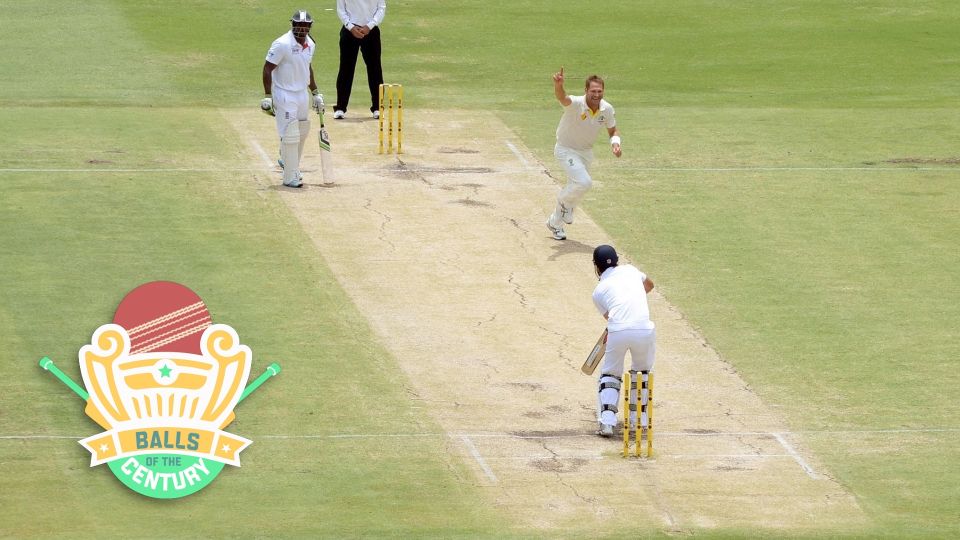


The perfect delivery, from a bowler who often tried too hard to bowl such balls
Australia v England, Perth 2013
Numerous times a year Ryan Harris is posed a familiar question. Friends, acquaintances and cricket lovers want to know one thing, and Harris invariably has the same response for them. He would say the same to Alastair Cook too, if the recipient of what a panel of ESPNcricinfo staff have voted the ball of this century ever asked Harris what the hell happened.
"A lot of people have asked me, 'How do you get the ball to swing after it bounces?'" Harris says. "But that's not me doing that.
"My job was to put it on a good length and line and then keep the seam upright, so I give myself every chance to swing it or get it to seam when the ball hits the wicket. It's quite amazing how [the Cook delivery] bounces and swings away as it did."
Amazing? Undoubtedly. Freakish? Most certainly. But accidental? That would be too great a disservice to Harris' rich fast bowling gifts. It is a common rebuke directed at fast bowlers that they sometimes try too hard to bowl the perfect ball; for Harris, over the majority of his topsy-turvy career, it was both external criticism and inner monologue.
Ryan Harris talks about the ball of the century
Blessed with a swing-and-seam artist's wrist, of the kind possessed by Glenn McGrath and Richard Hadlee, to name two, Harris could snap his fingers down behind the ball and so impart beautiful backspin and just enough wobble to keep all parties guessing exactly what would happen next.
But that blessing often manifested as a curse in his earlier years, when, also battling his body's lack of strength to cope with the rigours of fast bowling, and a shortfall in genuine belief and confidence in his quality, Harris would drag too short, float too full, or drift too wide. South Australia team-mates who groped unsuccessfully at balls snaking in or zipping away in the nets would often wonder where his poise went. It was sacrificed, as often as not, at the altar of trying too hard to bowl the perfect ball.
The self-recriminatory thoughts were still there, if buried a little more deeply in Harris' subconscious, when Michael Clarke tossed him the new Kookaburra for the start of England's second innings at the WACA in 2013. In moving to Queensland in 2008, gaining an Australia ODI debut in 2009, and a baggy green in 2010, Harris had found ways of subsuming his former perfectionism within greater discipline, consistent success, and by concentrating on less precise thoughts, about ensuring he "challenged the drive" of the batsman and "got it through to Hadds" behind the stumps.
Motion graphics: Ishita Mazumder
Even so, the starts of spells were times when Harris still strained too hard, scuffing the new ball with deliveries that were either too straight, as in his first over of this Ashes series, or too wide as in his next four. With time and overs, Harris warmed into a succession of superb spells in support of Mitchell Johnson, but his initial bursts were short of the standard he wanted - and the one that most admiring spectators remember. Cook, harried as he was on this tour of torment, could have expected a sighter or two.
Australia were ten wickets away from claiming the Ashes back for the first time since 2007, and adrenaline pulsed through a team that had watched George Bailey thud 28 runs off James Anderson's last over before Clarke's declaration. Harris tried his best to get warm and loose, as much as a dodgy right knee would let him, before commencing his run to the wicket. Side-on broadcast footage captures the merest hint of hesitation in his approach; between Harris' ears, there was more. That old perfectionist voice was at him.
"Halfway through my run-up, the voice in my head said, 'Stop, pull out', because at the time my first overs weren't that good," he says. "I was starting out bowling some half-volleys and four-balls. But for some reason I just kept going.
"I don't know why it was that I kept going, because one thing I always say to bowlers now when I'm teaching them is if you don't feel right running in, stop. To this day, I'll never know why I kept going!"
There was, perhaps, a sense of not wanting Cook see him stop. So much of the Australians' pre-series planning had focused upon how Cook, as captain and prolific opening batsman, would be the difference between a sturdy England and a brittle one. Clarke had explicitly targeted him in meetings before the first Test, and Harris had taken much from the preceding series in England, where Cook had gradually been worn down by his persistence.
"Get him forward and onto the front foot. My goal was to swing it into middle and off stumps, and if it didn't swing and went straight on, they were a couple that he nicked. Try and drag him forward and get him on the drive - not that he drove too much, but that was the length I was looking for. Hopefully swing it back in, and if it didn't, hopefully it seamed or went straight on. They were the options I had and the options I was trying to exploit every time I bowled to him."
Among cricket's multitude of players and followers, perhaps only Cook himself now wishes that Harris had restarted his run. The ball released from the Prindiville Stand end, aided by the first stirrings of that afternoon's Fremantle Doctor, started on an angle to perhaps miss off stump then swerved perceptibly in towards Cook through the air, forcing a defensive shot from a batsman wary of getting too far forward on a surface full of cracks.
So straight was the seam, so precise the length and so helpful the spot on the pitch where the ball landed, that Cook's bat and hands then had to contend with something few have ever seen, almost certainly not to a delivery as well aimed as this.
Upon contact with the surface, the seam was perfectly upright, and in its brief journey from pitch to batsman it started to swing again, this time away from Cook's bat. So late was the movement that Cook looked to have the ball covered until it was less than a metre from him, whence it curled cruelly away to dispose of the off bail. Many simply assumed the ball had seamed, and still thought so after initial replays.
Should you pull out of a delivery if you don't feel right? Don't ask Ryan Harris
Robert Cianflone / © Getty Images

"In England you can see it swing a lot after pitching, but that's usually three quarters of the way to the 'keeper." Harris says. "I can't remember anything like that [Perth ball]. The next best one would've been that Joe Root one [in Durham, earlier in 2013]. But I bowled a couple of good balls in South Africa to AB de Villiers, the second new ball in that Cape Town Test [in 2014], bowled a couple good ones to Alviro Petersen, but more seam than anything.
Reactions were instantly rapturous. "Ohhh, straight away" bawled James Brayshaw on Nine's commentary, while Harris went on a celebratory run that would not have been out of place at Wembley on FA Cup final day. Cook's own spontaneous response with the ball beginning to swerve after pitching was to open his mouth in horror, before closing it just enough for the deflated exhale of the vanquished and a last look behind at the broken stumps. After he had dismissed Cook once again in the last Test of the series, Harris shared a consoling word.
"I remember sitting down and having a beer with him and saying, 'Mate, you copped some decent balls', and talking about how it was a great battle and had been over the last six months, playing back to back series," Harris says. "I always had a lot of respect for him, what he'd done before and what he did before he retired. I always found it was a great battle because I played three Ashes series and bowled to him a lot."
It says much for Harris' capabilities that in Cook's words, England's best hope before the series was less about finding a way to cope with him and more about retaining a reasonable expectation that his problematic body would fail, as it had done during the 2010-11 Ashes and several other times besides. "Would Harris revert to type and struggle to sustain himself physically over a series?" Cook wrote in his autobiography. "Harris would be forced to retire in 2015 through a knee injury, but these were the days of his life."
Six years later, Harris is never far away from a reminder about the ball of his life. The enjoyment of it has never veered too far from the reaction of the first two team-mates to realise how special it was: wicketkeeper Brad Haddin, and first slip, Shane Watson.
"Watto and Hadds had a really good view of it," says Harris. "Watto came up and said, 'Jesus, that was a good one', and the rest of them realised what had happened when they saw the big screen, and there was a bit more excitement then. It was a nice feeling again to see it up there."
Up there is where it has remained. The perfect ball, and Ryan Harris bowled it.
Daniel Brettig is an assistant editor at ESPNcricinfo. @danbrettig
© ESPN Sports Media Ltd.
